测试策略范文范文
护肤测评策划书范文3篇

护肤测评策划书范文3篇篇一《护肤测评策划书范文》一、引言随着人们对美的追求不断提高,护肤产品在市场上的竞争日益激烈。
为了帮助消费者更好地了解各类护肤产品的功效和质量,我们计划进行一次全面的护肤测评。
本策划书将详细阐述测评的目的、方法、流程、预期结果以及宣传推广等方面的内容。
二、测评目的1. 为消费者提供客观、准确的护肤产品评价信息,帮助他们做出明智的购买决策。
2. 了解不同护肤品牌和产品的市场表现,为品牌推广和产品研发提供参考依据。
三、测评对象1. 洁面产品:包括洗面奶、洁面皂等。
2. 爽肤水:具有保湿、调理肌肤等功效的产品。
3. 乳液/面霜:滋润肌肤、提供营养的护肤品。
4. 精华液:具有特定功效的高浓度护肤产品,如美白、抗皱等。
5. 面膜:包括贴片式、涂抹式等不同类型的面膜。
四、测评方法1. 产品筛选:通过市场调研、品牌推荐和用户反馈等渠道,筛选出具有代表性的护肤产品。
2. 实验室测试:将部分产品送往专业的实验室进行成分分析、功效测试等,获取科学的数据支持。
3. 用户试用:邀请志愿者参与产品试用,记录使用感受、效果反馈等信息。
4. 综合评价:结合实验室测试结果和用户试用反馈,对产品进行综合评价,包括产品功效、质地、使用感、性价比等方面。
五、测评流程1. 筹备阶段:确定测评团队成员,明确分工。
与实验室合作,确定测试项目和方法。
准备测评所需的产品、仪器设备和测试工具。
设计调查问卷和试用表格。
2. 产品收集阶段:按照测评对象,收集各类护肤产品。
对产品进行初步筛选,剔除不符合要求的产品。
3. 实验室测试阶段:将选定的产品送往实验室进行成分分析、功效测试等。
等待实验室测试结果,并对数据进行整理和分析。
4. 用户试用阶段:招募志愿者参与产品试用,确保志愿者的肤质和需求具有代表性。
向志愿者发放产品和试用表格,指导他们正确使用产品并填写反馈信息。
定期收集志愿者的试用反馈,解答他们的疑问。
5. 综合评价阶段:结合实验室测试结果和用户试用反馈,对产品进行综合评价。
测试方案范文
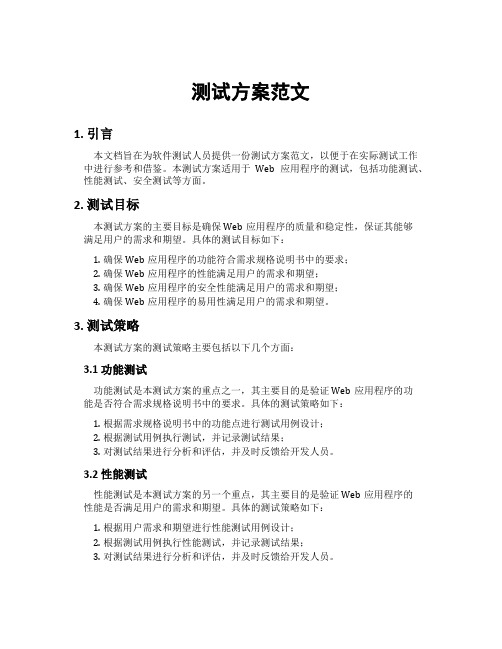
测试方案范文1. 引言本文档旨在为软件测试人员提供一份测试方案范文,以便于在实际测试工作中进行参考和借鉴。
本测试方案适用于Web应用程序的测试,包括功能测试、性能测试、安全测试等方面。
2. 测试目标本测试方案的主要目标是确保Web应用程序的质量和稳定性,保证其能够满足用户的需求和期望。
具体的测试目标如下:1.确保Web应用程序的功能符合需求规格说明书中的要求;2.确保Web应用程序的性能满足用户的需求和期望;3.确保Web应用程序的安全性能满足用户的需求和期望;4.确保Web应用程序的易用性满足用户的需求和期望。
3. 测试策略本测试方案的测试策略主要包括以下几个方面:3.1 功能测试功能测试是本测试方案的重点之一,其主要目的是验证Web应用程序的功能是否符合需求规格说明书中的要求。
具体的测试策略如下:1.根据需求规格说明书中的功能点进行测试用例设计;2.根据测试用例执行测试,并记录测试结果;3.对测试结果进行分析和评估,并及时反馈给开发人员。
3.2 性能测试性能测试是本测试方案的另一个重点,其主要目的是验证Web应用程序的性能是否满足用户的需求和期望。
具体的测试策略如下:1.根据用户需求和期望进行性能测试用例设计;2.根据测试用例执行性能测试,并记录测试结果;3.对测试结果进行分析和评估,并及时反馈给开发人员。
3.3 安全测试安全测试是本测试方案的另一个重点,其主要目的是验证Web应用程序的安全性能是否满足用户的需求和期望。
具体的测试策略如下:1.根据安全规范和标准进行安全测试用例设计;2.根据测试用例执行安全测试,并记录测试结果;3.对测试结果进行分析和评估,并及时反馈给开发人员。
3.4 易用性测试易用性测试是本测试方案的最后一个重点,其主要目的是验证Web应用程序的易用性是否满足用户的需求和期望。
具体的测试策略如下:1.根据用户需求和期望进行易用性测试用例设计;2.根据测试用例执行易用性测试,并记录测试结果;3.对测试结果进行分析和评估,并及时反馈给开发人员。
XXX项目测试方案范文模板 (一)

XXX项目测试方案范文模板 (一)XXX项目测试方案范文模板随着科技的发展,越来越多的人开始相信技术创新的力量,这也促进了各行各业的数字化和智能化发展。
在这种趋势下,XXX项目的出现,为市场带来了许多新的机会和挑战。
为了确保该项目的可靠性、稳定性和优质性,测试就成为了不可或缺的环节。
本文将为大家介绍一份针对XXX项目的测试方案范文模板,以帮助各位测试人员更好地进行该方面的工作。
一、测试目的在介绍具体测试步骤之前,我们需要先明确测试的目的。
XXX项目测试的目的是保证产品的安全、稳定、可靠、高效、易用和用户友好。
同时,也需要在不同的环境、平台、设备和网络条件下测试,以确保产品的兼容性、可用性和高性能。
二、测试覆盖范围测试的覆盖范围是测试的一个重要方面,它决定了测试的深度和广度。
XXX项目的测试覆盖范围主要包括以下几个方面:1.功能测试:主要测试产品的各种功能是否正常、完整、可靠和易用,包括输入、输出、计算、处理、存储、传输、交互、权限等方面。
2.性能测试:主要测试产品的响应时间、内存占用、磁盘占用、网络带宽等性能指标是否达到预期要求。
3.兼容性测试:主要测试产品在不同平台、环境、浏览器、设备和网络条件下是否正常工作。
4.界面测试:主要测试产品的界面设计是否美观、简洁、易用和符合用户习惯。
5.安全测试:主要测试产品的安全性,包括信息加密、病毒防护、权限管理等方面。
6.易用性测试:主要测试产品是否符合用户体验、界面友好、指引清晰等方面。
三、测试计划制定测试计划是测试的前提和保障,也是测试的关键环节。
XXX项目的测试计划主要包括以下几个方面:1.测试环境:确定测试需要使用的环境,例如硬件、软件、网络,以及与产品的集成和互动情况。
2.测试工具:确定测试需要使用的软件工具,例如自动化测试工具、性能测试工具、安全测试工具、缺陷管理工具等。
3.测试任务:制定测试的具体任务,包括测试的时间、人员、活动和文档等。
4.测试用例:编写和管理测试用例,确保测试步骤和预期结果得到充分的覆盖和检测。
软件测试策略范文
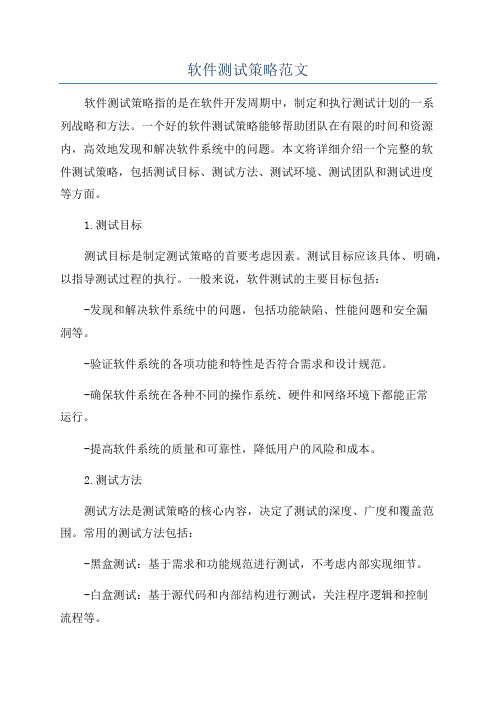
软件测试策略范文软件测试策略指的是在软件开发周期中,制定和执行测试计划的一系列战略和方法。
一个好的软件测试策略能够帮助团队在有限的时间和资源内,高效地发现和解决软件系统中的问题。
本文将详细介绍一个完整的软件测试策略,包括测试目标、测试方法、测试环境、测试团队和测试进度等方面。
1.测试目标测试目标是制定测试策略的首要考虑因素。
测试目标应该具体、明确,以指导测试过程的执行。
一般来说,软件测试的主要目标包括:-发现和解决软件系统中的问题,包括功能缺陷、性能问题和安全漏洞等。
-验证软件系统的各项功能和特性是否符合需求和设计规范。
-确保软件系统在各种不同的操作系统、硬件和网络环境下都能正常运行。
-提高软件系统的质量和可靠性,降低用户的风险和成本。
2.测试方法测试方法是测试策略的核心内容,决定了测试的深度、广度和覆盖范围。
常用的测试方法包括:-黑盒测试:基于需求和功能规范进行测试,不考虑内部实现细节。
-白盒测试:基于源代码和内部结构进行测试,关注程序逻辑和控制流程等。
-灰盒测试:结合黑盒和白盒测试方法,既考虑功能需求,也考虑内部实现。
-自动化测试:使用测试工具和脚本自动执行测试用例,提高测试效率和可靠性。
3.测试环境测试环境是指完成测试所需要的硬件、软件和网络等资源。
一个好的测试环境能够模拟真实的使用场景,提供准确的测试数据和条件。
常见的测试环境包括:-开发环境:用于软件开发和调试,包括开发工具、源代码和调试器等。
-测试环境:用于执行测试用例和验证软件系统的功能和性能等。
测试环境应具备和生产环境相似的硬件配置和软件版本。
-模拟环境:用于模拟特定的操作系统、硬件和网络环境等,以测试软件在不同环境下的兼容性和稳定性。
4.测试团队测试团队是负责执行测试策略和完成测试任务的核心力量。
测试团队的组成应该根据软件项目的规模和复杂程度进行合理安排。
一个典型的测试团队包括:-测试经理:负责制定和执行测试策略,并协调各个测试资源和任务。
回归测试策略范文

回归测试策略范文回归测试是软件测试的一种方法,用于验证修改或添加新功能后对现有软件的影响。
回归测试策略是指在回归测试过程中所采取的方法和规划,以确保有效和高效地执行回归测试。
以下是一些回归测试策略和实践的关键点,这些点可以帮助测试团队规划和执行回归测试:1.确定回归测试的范围:在开始回归测试之前,需要明确回归测试的范围。
这包括被修改或新增的功能、影响到的相关功能和相关的测试用例。
2.优先级建议:通过分析需求和修改的影响,为回归测试中的功能和测试用例设置优先级。
这有助于确保有限的资源和时间用于最重要的回归测试部分。
3.自动化回归测试:回归测试中的一部分或全部可以自动化。
自动化回归测试可以提高测试效率和准确性。
为了自动化测试,测试团队需要选择合适的自动化工具,并编写可重复执行的测试脚本。
5.针对失败测试的重新测试:在之前的版本中发现的一些失败的测试用例可能会在新版本中再次失败。
这些测试用例应该在回归测试中重新运行,以验证修复是否有效。
6.随机选择测试用例:为了验证软件在修改后的整体稳定性,可以随机选择一部分测试用例执行。
这可以帮助发现意外的问题和潜在的副作用。
7.分阶段回归测试:如果软件的修改较大或回归测试工作量较大,可以将回归测试划分为几个阶段进行。
每个阶段都会验证一部分功能,并在下一个阶段中构建和添加新的测试。
8.回归测试数据:为了执行回归测试,测试团队需要合适的测试数据。
这可能包括真实的或模拟的数据集,以确保测试的完整性和正确性。
9.定期执行回归测试:回归测试应该是一个定期执行的活动,以确保对软件进行及时的检查和验证。
最好在每个版本发布之前执行一次完整的回归测试。
10.结果追踪和报告:回归测试的结果应该被追踪和记录下来,以便分析和审查。
测试团队应该生成详细的测试报告,其中包括测试结果、问题和意见。
总之,回归测试策略是确保回归测试执行的有效性和高效性的关键。
通过合适的范围、优先级、自动化、针对修改和失败的测试、随机选择、分阶段、测试数据、定期执行以及结果追踪和报告,测试团队可以有效地执行回归测试并验证软件的稳定性和正确性。
测试工作计划报告范文
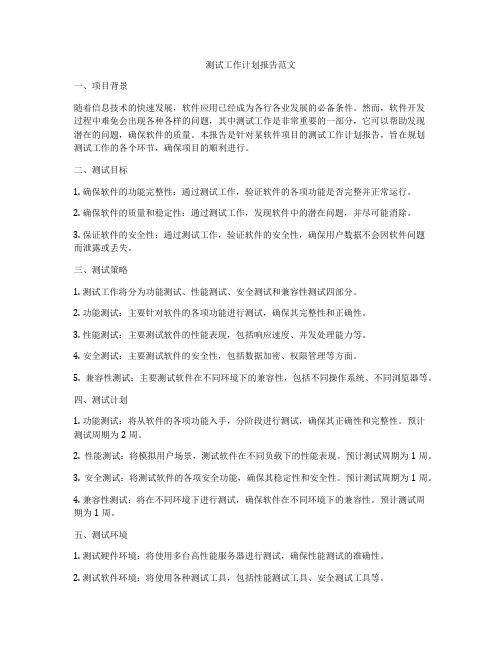
测试工作计划报告范文一、项目背景随着信息技术的快速发展,软件应用已经成为各行各业发展的必备条件。
然而,软件开发过程中难免会出现各种各样的问题,其中测试工作是非常重要的一部分,它可以帮助发现潜在的问题,确保软件的质量。
本报告是针对某软件项目的测试工作计划报告,旨在规划测试工作的各个环节,确保项目的顺利进行。
二、测试目标1. 确保软件的功能完整性:通过测试工作,验证软件的各项功能是否完整并正常运行。
2. 确保软件的质量和稳定性:通过测试工作,发现软件中的潜在问题,并尽可能消除。
3. 保证软件的安全性:通过测试工作,验证软件的安全性,确保用户数据不会因软件问题而泄露或丢失。
三、测试策略1. 测试工作将分为功能测试、性能测试、安全测试和兼容性测试四部分。
2. 功能测试:主要针对软件的各项功能进行测试,确保其完整性和正确性。
3. 性能测试:主要测试软件的性能表现,包括响应速度、并发处理能力等。
4. 安全测试:主要测试软件的安全性,包括数据加密、权限管理等方面。
5. 兼容性测试:主要测试软件在不同环境下的兼容性,包括不同操作系统、不同浏览器等。
四、测试计划1. 功能测试:将从软件的各项功能入手,分阶段进行测试,确保其正确性和完整性。
预计测试周期为2周。
2. 性能测试:将模拟用户场景,测试软件在不同负载下的性能表现。
预计测试周期为1周。
3. 安全测试:将测试软件的各项安全功能,确保其稳定性和安全性。
预计测试周期为1周。
4. 兼容性测试:将在不同环境下进行测试,确保软件在不同环境下的兼容性。
预计测试周期为1周。
五、测试环境1. 测试硬件环境:将使用多台高性能服务器进行测试,确保性能测试的准确性。
2. 测试软件环境:将使用各种测试工具,包括性能测试工具、安全测试工具等。
3. 测试人员:将由专业的测试人员组成测试团队,确保测试工作的质量和效率。
六、风险评估1. 由于软件项目的复杂性,可能会导致一些潜在的问题没有被发现。
软件单元测试方案范文

软件单元测试方案范文软件单元测试方案范文一、引言本文档旨在对软件单元测试方案进行详细的描述,包括测试目标、测试策略、测试环境、测试计划、测试用例设计和执行等内容。
二、测试目标1. 验证每个软件单元的功能是否满足需求规格说明书中描述的功能要求。
2. 检查每个软件单元是否存在潜在的错误、缺陷或逻辑问题。
3. 确认每个软件单元是否符合规范和标准。
三、测试策略1. 自底向上测试策略:从最底层的模块开始逐层测试,确保每个模块的功能和接口都能正常工作。
2. 黑盒测试策略:仅基于输入和输出,不关心内部实现细节,以验证软件单元的功能是否符合预期。
3. 白盒测试策略:结合对内部实现细节的了解,通过验证软件单元的每个路径、每个条件和每个分支,以确保软件单元的每个部分都能正确工作。
四、测试环境1. 操作系统:Windows、Linux、Mac OS等。
2. 开发环境:Java、C++、Python等。
3. 测试工具:Junit、PHPUnit、Selenium等。
五、测试计划1. 根据项目进度和需求优先级,确定软件单元的测试顺序和每个测试阶段的时间规划。
2. 分配测试资源和人员,确保测试工作按计划进行。
3. 根据测试结果,及时调整测试计划,重新安排测试工作。
六、测试用例设计1. 根据需求规格说明书,提取关键功能点和边界条件作为测试用例的设计依据。
2. 设计正向测试用例、异常测试用例和边界测试用例,以全面覆盖软件单元的功能和边界情况。
3. 使用等价类划分、边界值分析和错误推测等方法,设计高效、有效的测试用例。
七、测试用例执行1. 根据测试计划和测试用例设计,逐个执行测试用例,记录测试结果。
2. 对于执行失败的测试用例,及时提交缺陷报告,并跟踪缺陷的修复进度。
3. 针对复杂的测试场景,使用自动化测试工具进行测试用例的执行。
八、测试结果分析和评估1. 对测试结果进行统计和分析,评估软件单元的功能和质量。
2. 根据测试结果,提出改进建议,优化软件单元的设计和实现。
存储测试方案范文
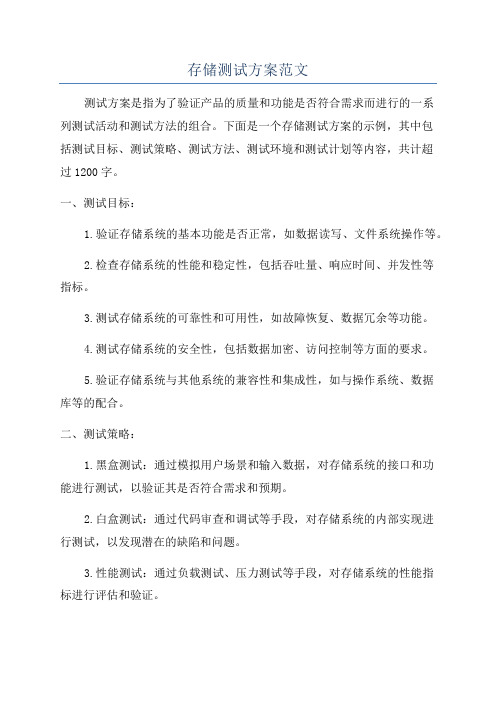
存储测试方案范文测试方案是指为了验证产品的质量和功能是否符合需求而进行的一系列测试活动和测试方法的组合。
下面是一个存储测试方案的示例,其中包括测试目标、测试策略、测试方法、测试环境和测试计划等内容,共计超过1200字。
一、测试目标:1.验证存储系统的基本功能是否正常,如数据读写、文件系统操作等。
2.检查存储系统的性能和稳定性,包括吞吐量、响应时间、并发性等指标。
3.测试存储系统的可靠性和可用性,如故障恢复、数据冗余等功能。
4.测试存储系统的安全性,包括数据加密、访问控制等方面的要求。
5.验证存储系统与其他系统的兼容性和集成性,如与操作系统、数据库等的配合。
二、测试策略:1.黑盒测试:通过模拟用户场景和输入数据,对存储系统的接口和功能进行测试,以验证其是否符合需求和预期。
2.白盒测试:通过代码审查和调试等手段,对存储系统的内部实现进行测试,以发现潜在的缺陷和问题。
3.性能测试:通过负载测试、压力测试等手段,对存储系统的性能指标进行评估和验证。
4.安全测试:对存储系统的安全机制和措施进行测试,包括数据加密、用户认证、访问控制等方面。
5.兼容性测试:测试存储系统与其他系统的集成和协同工作的能力,包括操作系统、数据库、网络设备等。
三、测试方法:1.功能测试:通过编写测试用例,对存储系统的各项基本功能进行测试,包括数据读写、文件管理、数据备份和恢复等方面。
2.性能测试:通过压力测试工具和性能测试脚本,对存储系统的吞吐量、响应时间、并发性等指标进行评估和验证。
3.安全测试:通过黑盒测试和白盒测试方法,对存储系统的安全机制和措施进行测试,包括数据加密、用户认证、访问控制等方面。
4.兼容性测试:通过集成测试和兼容性测试方法,对存储系统与其他系统的集成和协同工作能力进行测试,包括操作系统、数据库、网络设备等。
5.故障恢复测试:通过模拟故障场景和恢复操作,对存储系统的故障恢复能力进行测试,包括数据冗余、备份和恢复等方面。
软件测试的策略范文
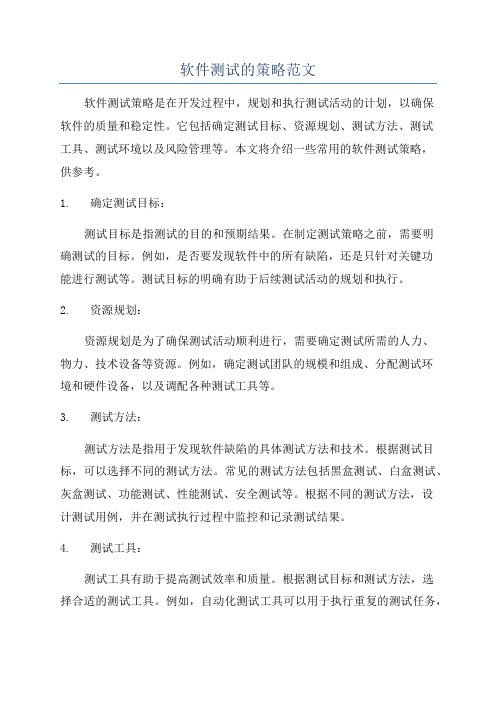
软件测试的策略范文软件测试策略是在开发过程中,规划和执行测试活动的计划,以确保软件的质量和稳定性。
它包括确定测试目标、资源规划、测试方法、测试工具、测试环境以及风险管理等。
本文将介绍一些常用的软件测试策略,供参考。
1. 确定测试目标:测试目标是指测试的目的和预期结果。
在制定测试策略之前,需要明确测试的目标。
例如,是否要发现软件中的所有缺陷,还是只针对关键功能进行测试等。
测试目标的明确有助于后续测试活动的规划和执行。
2. 资源规划:资源规划是为了确保测试活动顺利进行,需要确定测试所需的人力、物力、技术设备等资源。
例如,确定测试团队的规模和组成、分配测试环境和硬件设备,以及调配各种测试工具等。
3. 测试方法:测试方法是指用于发现软件缺陷的具体测试方法和技术。
根据测试目标,可以选择不同的测试方法。
常见的测试方法包括黑盒测试、白盒测试、灰盒测试、功能测试、性能测试、安全测试等。
根据不同的测试方法,设计测试用例,并在测试执行过程中监控和记录测试结果。
4. 测试工具:测试工具有助于提高测试效率和质量。
根据测试目标和测试方法,选择合适的测试工具。
例如,自动化测试工具可以用于执行重复的测试任务,提高测试效率;性能测试工具可以用于模拟并测量系统在负荷下的性能。
测试工具的选择应根据项目需求和可用资源进行权衡。
5. 测试环境:测试环境是进行软件测试所需的软硬件环境的配置。
例如,确定测试使用的操作系统、数据库、网络环境等。
测试环境的准备有助于保证测试的可靠性和有效性。
测试环境应尽可能与实际部署环境保持一致,以避免由于环境差异导致的测试结果不准确。
6. 风险管理:软件测试过程中,可能存在各种风险,如进度延迟、资源不足、质量不达标等。
为了规避这些风险,需要进行风险评估和治理。
在测试策略中,应明确风险的概率和影响,并制定相应的应对措施。
例如,增加资源投入、优先处理高风险功能等。
7. 测试评审和跟踪:测试评审和跟踪是测试策略中的重要环节。
测试方案范文

测试方案范文在软件开发的过程中,测试是一项至关重要的环节。
它可以帮助开发人员发现和修复潜在的问题,确保软件的质量和稳定性。
然而,为了进行有效的测试,需要制定一份完善的测试方案。
本文将提供一个测试方案的范文,以供参考。
一、测试概述测试概述部分主要对测试的目标、范围和方法进行描述。
例如,在这一部分可以明确测试的主要目的是验证软件的正确性和稳定性,测试范围涵盖了各个软件模块以及其功能和交互等方面。
测试方法可以包括自动化测试、手工测试以及性能测试等。
二、测试环境测试环境部分需要详细描述测试所使用的硬件和软件环境。
例如,硬件环境可以包括测试计算机型号、处理器和内存等配置要求。
软件环境可以包括操作系统、数据库以及其他必要的软件和工具等。
三、测试策略测试策略部分需要制定各种测试类型的策略。
例如,功能测试策略可以包括界面测试、逻辑测试和数据输入测试等。
性能测试策略可以包括负载测试、压力测试和并发测试等。
此外,还可以包括测试用例设计和执行等相关策略。
四、测试计划测试计划部分需要明确测试的时间安排、资源分配和测试阶段。
测试时间安排可以根据整个软件开发周期来确定,以确保测试能够及时进行。
资源分配可以包括人力、物力和时间等方面的分配。
测试阶段可以分为单元测试、集成测试和系统测试等。
五、测试执行测试执行部分是具体执行测试过程的描述。
可以根据测试用例逐一测试各个功能模块,并记录测试结果。
在测试执行过程中,可以使用一些辅助工具和测试脚本来提高效率和准确性。
六、测试评估和报告测试评估和报告部分需要对测试结果进行评估,并形成测试报告。
测试报告应该包括测试的目标、范围、方法、结果和建议等内容。
测试结果可以按照严重性和优先级进行分类,以帮助开发人员有针对性地解决问题。
七、风险管理风险管理部分需要对测试过程中可能出现的风险进行识别和规避。
例如,可能会因为测试时间不足而导致测试覆盖度不够,可以提前规划好测试时间,确保有足够的时间进行测试。
软件测试计划范文3篇

软件测试计划范文3篇篇一:软件测试计划1(简介1.1目的,项目名称,的这一“测试计划”文档有助于实现以下目标: [确定现有项目的信息和应测试的软件构件。
列出推荐的测试需求。
推荐可采用的测试策略,并对这些策略加以说明。
确定所需的资源,并对测试的工作量进行估计。
列出测试项目的可交付元素]1.2背景[对测试对象及其目标进行简要说明。
需要包括的信息有:主要的功能和性能、测试对象的构架以及项目的简史。
]1.3范围[描述测试的各个阶段,并说明本计划所针对的测试类型。
简要地列出测试对象中将接受测试或将不接受测试的那些性能和功能。
如果在编写此文档的过程中做出的某些假设可能会影响测试设计、开发或实施,则列出所有这些假设。
列出可能会影响测试设计、开发或实施的所有风险或意外事件。
列出可能会影响测试设计、开发或实施的所有约束。
2. 测试参考文档和测试提交文档2.1测试参考文档下表列出了制定测试计划时所使用的文档,并标明了各文档的可用性:[注:可适当地删除或添加文档项。
]文档、已创建或可用、已被接收或已经过复审、作者或可行性分析报告、是? 否?、是? 否?需求规格说明书、是? 否?、是? 否?软件概要设计、是? 否?、是? 否?软件详细设计、是? 否?、是? 否?软件测试需求、是? 否?、是? 否?测试时间表及人员安排、是? 否?、是? 否?用户操作手册、是? 否?、是? 否?安装指南、是? 否?、是? 否?2.2测试提交文档[下面应当列出在测试阶段结束后,所有可提交的文档]例如:测试报告,测试用例3.测试进度测试活动、计划开始日期、实际开始日期、结束日期、完成人员制定测试计划设计测试用例集成测试系统测试性能测试安装测试用户验收测试对测试进行评估产品发布4.测试资源4.1人力资源下表列出了在此项目的人员配备方面所作的各种假定。
[注:可适当地删除或添加角色项。
]角色所推荐的最少资源具体职责或注释4.2测试环境软件描述硬件描述4.3测试工具此项目将列出测试使用的工具:用途工具生产厂商/自产版本5.测试风险评估、优先级[简要描述测试阶段的风险和处理的优先级]6.测试策略[测试策略提供了对测试对象进行测试的推荐方法。
产品测试方案范文

产品测试方案范文一、背景和目标在产品开发的过程中,产品测试是保证产品质量和稳定性的重要环节。
本次产品测试旨在验证产品的功能、性能、用户体验以及故障恢复能力等方面。
通过全面、系统地测试产品,确保产品能够达到客户的期望需求,并提供良好的用户体验。
二、测试策略1.测试对象:本次测试将针对新开发的产品进行测试,包括功能模块、性能、网站或移动应用程序等。
2.测试类型:a.功能测试:验证产品的功能是否符合需求规格说明书中的描述。
b.性能测试:测试产品在不同负载和压力下的性能表现。
c.兼容性测试:评估产品在不同操作系统、浏览器或设备上的兼容性。
d.安全性测试:检查产品的安全性,确保用户的数据和隐私受到保护。
e.用户体验测试:评估产品在真实用户使用场景下的易用性和用户满意度。
f.故障恢复测试:测试产品在出现故障时的恢复能力和稳定性。
g.回归测试:在每次修改或更新后,重新进行测试以确保之前系统功能正常的部分仍然正常。
三、测试环境1.硬件环境:测试所需的硬件设备,包括计算机、移动设备和网络设备等。
2.软件环境:测试所需的操作系统、浏览器、数据库和相关工具等。
四、测试计划1.制定测试计划:根据产品的需求规格说明书和开发计划,制定详细的测试计划。
2.设计测试用例:根据需求和功能点,设计功能测试用例,针对性能、兼容性、安全性和用户体验等设计对应的测试用例。
3.定义测试数据:准备测试所需的数据,并确保数据的真实性和多样性。
4.实施测试:按照测试计划和测试用例进行系统地测试,并详细记录测试结果和发现的问题。
5.分析测试结果:分析测试结果,确定问题的严重性和优先级,并给出相应的改进措施。
五、问题管理1.问题报告:及时记录和报告测试过程中发现的问题,包括问题的描述、复现步骤和截图等。
2.问题跟踪:追踪问题的解决过程,与开发人员沟通问题的原因和解决方案,并确保及时解决。
3.问题验证:在问题被解决后,进行验证测试以确保问题已得到解决。
软件测试策略范文

软件测试策略范文软件测试策略是指在软件开发过程中制定和执行的一系列测试活动和方法。
通过设计和实施一个合理的测试策略,可以提高软件质量,确保软件的功能和性能满足用户需求。
下面是一个关于软件测试策略的示例,详细说明了在软件测试过程中应该采取的步骤和方法。
1.确定测试目标和范围:制定测试策略的第一步是明确测试目标和范围。
测试目标应该与软件的需求和预期功能一致。
测试范围应该明确包括哪些功能和模块需要进行测试。
2.制定测试计划:测试策略需要制定一个详细的测试计划,明确测试环境、测试资源、测试工具等方面的要求。
测试计划应该包括测试的时间表、人员分配、测试用例等信息。
3.设计测试用例:测试用例是软件测试的重要组成部分。
测试策略应该明确设计测试用例的方法和原则。
测试用例应该覆盖软件的各个功能和模块,以确保对软件的全面测试。
4.执行测试用例:测试策略要求在测试环境中执行测试用例。
测试人员应按照测试计划和用例,逐一执行测试用例,并记录测试结果。
5.分析测试结果:测试策略要求对测试结果进行分析和评估,以确定软件是否达到预期质量标准。
测试人员应将测试结果与预期结果进行对比,记录并解决测试中发现的问题。
6.缺陷管理:测试策略要求建立一个缺陷管理系统,以收集和记录测试中发现的缺陷。
测试人员应将所有的缺陷及其相关信息进行记录,并跟踪解决过程,确保所有的缺陷得到及时修复。
7.回归测试:测试策略要求在进行修复后的软件版本上执行回归测试,以确保修改的缺陷没有引入新的问题,并且软件的其他功能和模块没有受到影响。
8.性能测试:测试策略要求进行性能测试,以评估软件在不同负载条件下的性能表现。
性能测试可以包括负载测试、压力测试、稳定性测试等。
9.安全测试:测试策略要求进行安全测试,以评估软件在安全方面的漏洞和风险。
安全测试可以包括系统漏洞扫描、用户权限测试、数据加密测试等。
10.测试报告:测试策略要求生成测试报告,总结测试过程和结果,向相关人员提供测试的详细信息。
功能测试方案范文

功能测试方案范文1. 引言本文档是编写功能测试方案的范文,旨在提供如何编写功能测试方案的指导。
功能测试是一种软件测试方法,用于验证软件系统在满足需求规格说明书中所描述功能的前提下,是否按照预期的方式运行。
2. 测试目标本次功能测试的目标是验证新开发的学生管理系统是否满足以下功能要求:1.学生信息的录入、查询、修改、删除功能是否正常。
2.成绩录入和计算功能是否正常。
3.课程管理功能是否正常。
4.系统安全防护功能是否正常。
5.系统性能是否满足预期。
6.系统稳定性是否符合要求。
3. 测试策略测试策略是指为达到预期测试目标所采用的方法。
下面是本次功能测试的测试策略:1.功能覆盖测试:对于每一个功能模块,验证其相关的功能点是否都能正确运行。
2.边界测试:针对输入范围的边界条件进行测试,例如最大值、最小值、负值等。
3.异常测试:测试系统在错误输入、非法操作等异常条件下的反应和处理能力。
4.性能测试:测试系统在多用户、大数据量情况下的响应时间和吞吐量。
5.安全测试:测试系统在安全防护方面的功能是否正常,包括用户权限管理、数据加密等。
6.兼容性测试:测试系统在不同平台、不同浏览器、不同设备下的兼容性。
4. 测试环境本次功能测试使用的测试环境如下:•操作系统:Windows 10•浏览器:Google Chrome、Mozilla Firefox、Microsoft Edge•开发工具:Java、MySQL•设备:PC、平板电脑、手机5. 测试用例测试用例是测试过程中所执行的具体测试步骤和预期结果的描述。
下面是本次功能测试的测试用例示例:5.1 学生信息录入功能测试用例测试目标:验证学生信息录入功能是否正常。
测试步骤: 1. 打开学生管理系统。
2. 进入学生信息录入页面。
3. 输入学生姓名、学号、年龄、性别等信息。
4. 点击提交按钮。
预期结果: - 提交成功后,系统显示“学生信息录入成功”的提示信息。
- 学生信息出现在学生列表中。
客户测试方案模板范文

客户测试方案模板范文示例1:在撰写客户测试方案模板之前,首先要了解什么是客户测试方案。
客户测试方案是在产品开发过程中为客户提供集中测试的策略和规划的文档。
它的目的是确保产品的质量和符合客户需求。
下面是一个客户测试方案模板范文的示例:一、引言这一部分介绍了客户测试方案的背景和目的。
1.1 背景详细说明产品的背景信息,包括产品的发展历程、关键功能和技术。
1.2 目的明确客户测试的目的,例如测试产品的稳定性、性能和用户体验。
二、测试策略这一部分涵盖了客户测试的整体策略和方法。
2.1 测试目标明确客户测试的主要目标,例如发现和修复产品缺陷、验证和优化关键功能等。
2.2 测试范围确定客户测试的范围,包括测试涉及的功能、所覆盖的平台和操作系统等。
2.3 测试方法描述客户测试的方法和工具,可以包括手动测试、自动化测试、压力测试等。
三、测试计划这一部分详细规划了客户测试的时间表和任务分配。
3.1 测试时间表列出客户测试的时间安排,包括测试开始和结束时间、每个测试阶段的时间和里程碑等。
3.2 任务分配明确每个测试任务的负责人和责任,确保测试工作的分工合理和有效。
四、测试环境这一部分描述了客户测试的环境要求和设置。
4.1 硬件环境列出客户测试所需的硬件设备和配置要求。
4.2 软件环境列出客户测试所需的操作系统、浏览器和其他软件要求。
五、测试用例这一部分包含了具体的测试用例和测试数据。
5.1 测试场景描述客户测试的具体场景和用例。
5.2 测试数据提供客户测试所需的测试数据和条件。
六、风险评估这一部分评估客户测试中可能遇到的风险和问题,并提供相应的风险管理措施。
七、测试执行这一部分描述客户测试的具体执行过程。
7.1 测试步骤详细描述客户测试的步骤和操作。
7.2 缺陷管理明确缺陷报告和跟踪的流程和规范。
八、测试报告这一部分总结客户测试的结果和发现。
8.1 测试总结针对客户测试的目标和范围,总结测试的结果和评价。
8.2 缺陷报告列出所有客户测试中发现的缺陷,并提供适当的分类和描述。
测试方案范文
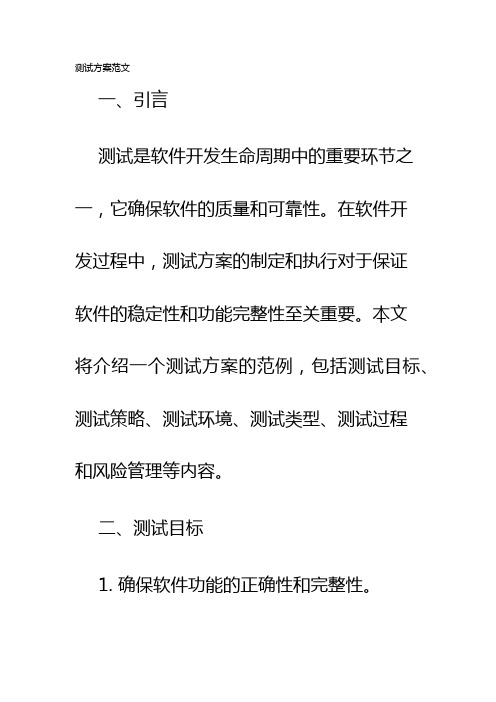
测试方案范文一、引言测试是软件开发生命周期中的重要环节之一,它确保软件的质量和可靠性。
在软件开发过程中,测试方案的制定和执行对于保证软件的稳定性和功能完整性至关重要。
本文将介绍一个测试方案的范例,包括测试目标、测试策略、测试环境、测试类型、测试过程和风险管理等内容。
二、测试目标1. 确保软件功能的正确性和完整性。
2. 确保软件的性能、安全性和稳定性。
3. 检查软件界面的友好性和易用性。
4. 验证软件是否符合用户需求和预期。
5. 提供可靠的测试结果和报告,以便开发团队对软件进行改进和优化。
三、测试策略在制定测试策略时,需要考虑以下因素:1. 制定详细的测试计划,明确测试的范围、时间和资源。
2. 选择适当的测试方法和技术,如黑盒测试、白盒测试、功能测试、性能测试等。
3. 定义合理的测试用例,涵盖不同的测试场景和边界条件。
4. 确保测试环境和测试数据的准备充分和稳定。
5. 设置测试结果和缺陷的评估标准,以便准确衡量软件质量。
四、测试环境测试环境是进行软件测试的基础设施,它需要满足以下要求:1. 所有测试所需的硬件设备,包括计算机、服务器、网络设备等。
3. 所有测试所需的软件环境,包括操作系统、数据库、开发工具等。
4. 测试数据库和测试数据的准备,以模拟真实使用场景。
5. 网络环境的搭建,确保测试网络的稳定性和可靠性。
五、测试类型根据软件的特点和需求,可以选择以下测试类型:1. 功能测试:验证软件的各项功能是否按设计要求正常工作。
2. 性能测试:测试软件在不同负载和压力下的性能表现。
3. 兼容性测试:测试软件在不同操作系统、浏览器和硬件平台上的兼容性。
4. 安全性测试:测试软件的安全机制和漏洞,确保其对攻击的抵抗能力。
5. 用户界面测试:检查软件界面的友好性和易用性。
6. 可靠性测试:测试软件的稳定性和可靠性,包括容错性和恢复性等。
六、测试过程测试过程需要有合理的计划和安排,包括以下步骤:1. 测试准备:准备测试环境、测试数据和测试用例。
测试计划优秀范文

测试计划优秀范文一、引言测试计划是软件测试工作的基础,它定义了测试的目标、范围、策略、资源和进度等。
一个完善的测试计划可以确保测试工作的顺利进行,同时也可以提高测试效率和提高软件的质量。
本文将为大家提供一个优秀的测试计划范文。
二、测试目标1.验证软件的功能是否符合需求规格说明书中的要求;2.发现并修复软件中的缺陷和问题;3.评估软件的性能和可靠性;4.确定软件是否满足用户的期望和需求。
三、测试范围1.功能测试:覆盖软件的所有功能,并进行详细的功能验证;2.兼容性测试:验证软件在不同平台和环境下的兼容性;3.性能测试:评估软件在正常和高负载条件下的性能表现;4.安全性测试:验证软件的安全性和防护机制;5.用户界面测试:验证软件的界面友好程度和易用性;6.防御性测试:评估软件的抗攻击和防御能力。
四、测试策略1.风险评估:根据软件的重要性和风险程度进行测试优先级的确定;2.自动化测试:对于易于测试和重复性较高的功能,采用自动化测试工具进行测试;3.回归测试:在每次软件迭代和修改后,进行回归测试以确保新功能的引入不会破坏原有功能;4.多样性测试:对于经常使用的功能,采用多种方式和数据进行测试,以覆盖更多的测试场景;5.错误处理:对于软件中可能出现的错误,进行详细的错误处理和报告。
五、测试资源1.人力资源:根据测试工作的复杂性和工作量,分配合适的测试人员;2.硬件资源:提供测试所需的硬件设备和服务器等;3.软件资源:提供测试所需的测试工具和测试环境;4.数据资源:提供测试所需的数据和测试用例。
六、测试进度1.阶段一:需求分析和测试计划编写,预计耗时1周;2.阶段二:功能测试,预计耗时2周;3.阶段三:兼容性测试和性能测试,预计耗时2周;4.阶段四:安全性测试和用户界面测试,预计耗时1周;5.阶段五:防御性测试和回归测试,预计耗时1周;6.阶段六:测试总结和报告编写,预计耗时1周。
七、风险评估和管理1.资源不足:在测试计划编写前,评估所需资源是否满足测试需求,如果缺乏资源,则尽早寻找解决方案;2.时间延误:对于测试进度偏后的情况,要及时调整测试策略和调整测试计划,以确保测试的顺利进行;3.未发现的缺陷:在测试过程中可能存在未发现的缺陷,要及时进行跟踪和修复;4.高风险功能:对于软件中的高风险功能,要进行重点测试和验证。
产品内部测试工作计划范文
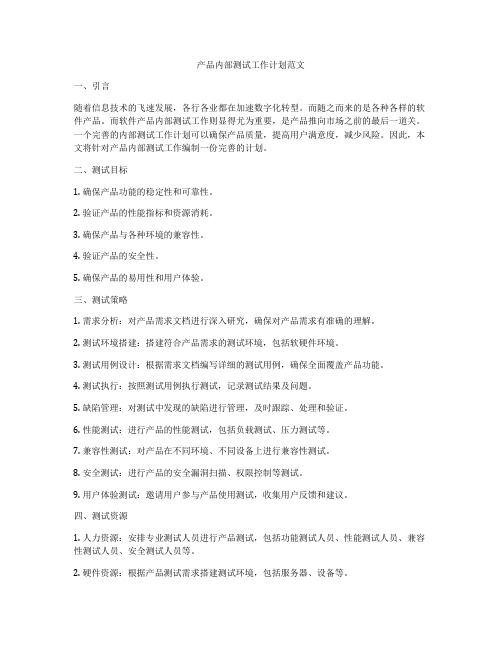
产品内部测试工作计划范文一、引言随着信息技术的飞速发展,各行各业都在加速数字化转型。
而随之而来的是各种各样的软件产品。
而软件产品内部测试工作则显得尤为重要,是产品推向市场之前的最后一道关。
一个完善的内部测试工作计划可以确保产品质量,提高用户满意度,减少风险。
因此,本文将针对产品内部测试工作编制一份完善的计划。
二、测试目标1. 确保产品功能的稳定性和可靠性。
2. 验证产品的性能指标和资源消耗。
3. 确保产品与各种环境的兼容性。
4. 验证产品的安全性。
5. 确保产品的易用性和用户体验。
三、测试策略1. 需求分析:对产品需求文档进行深入研究,确保对产品需求有准确的理解。
2. 测试环境搭建:搭建符合产品需求的测试环境,包括软硬件环境。
3. 测试用例设计:根据需求文档编写详细的测试用例,确保全面覆盖产品功能。
4. 测试执行:按照测试用例执行测试,记录测试结果及问题。
5. 缺陷管理:对测试中发现的缺陷进行管理,及时跟踪、处理和验证。
6. 性能测试:进行产品的性能测试,包括负载测试、压力测试等。
7. 兼容性测试:对产品在不同环境、不同设备上进行兼容性测试。
8. 安全测试:进行产品的安全漏洞扫描、权限控制等测试。
9. 用户体验测试:邀请用户参与产品使用测试,收集用户反馈和建议。
四、测试资源1. 人力资源:安排专业测试人员进行产品测试,包括功能测试人员、性能测试人员、兼容性测试人员、安全测试人员等。
2. 硬件资源:根据产品测试需求搭建测试环境,包括服务器、设备等。
3. 软件资源:准备测试工具和测试设备,确保测试工作的顺利进行。
五、测试计划1. 产品准备阶段:a. 确定测试范围和测试计划。
b. 准备测试环境。
c. 确定测试用例。
2. 功能测试阶段:a. 执行功能测试用例。
b. 对缺陷进行管理和修复验证。
c. 完成功能测试报告。
3. 性能测试阶段:a. 进行性能测试。
b. 分析性能测试结果。
c. 完成性能测试报告。
4. 兼容性测试阶段:a. 进行兼容性测试。
软件测试策略范文

软件测试策略范文Software testing is an essential part of the software development process as it helps ensure the quality and reliability of the final product. 软件测试是软件开发过程中不可或缺的一部分,因为它有助于确保最终产品的质量和可靠性。
One software testing strategy that is commonly used is the black-box testing strategy. 运用广泛的一种软件测试策略是黑盒测试策略。
This strategy focuses on testing the functionality of the software without looking at its internal code. 这种策略侧重于测试软件的功能,而不考虑其内部代码。
Another popular software testing strategy is the white-box testing strategy. 另一种流行的软件测试策略是白盒测试策略。
This strategy involves testing the software by examining its internal code and logic. 这种策略涉及通过检查软件的内部代码和逻辑来进行测试。
In addition to black-box and white-box testing, there are other testing strategies such as unit testing, integration testing, system testing, and acceptance testing. 除了黑盒测试和白盒测试,还有其他测试策略,如单元测试、集成测试、系统测试和验收测试。
- 1、下载文档前请自行甄别文档内容的完整性,平台不提供额外的编辑、内容补充、找答案等附加服务。
- 2、"仅部分预览"的文档,不可在线预览部分如存在完整性等问题,可反馈申请退款(可完整预览的文档不适用该条件!)。
- 3、如文档侵犯您的权益,请联系客服反馈,我们会尽快为您处理(人工客服工作时间:9:00-18:30)。
The development of a test strategy is a multi-step process of analysis:1.Analyze requirements.2.Assess risk.3.Define scope of testing.4.Determine test approach.5.Determine entry and exit criteria.一个测试策略的设计是一个多步骤的分析过程:1.分析需求。
2.评估风险。
3.定义测试范围。
4.确定测试方法。
5.确定进入和退出条件。
Once the requirements and risks of a project are well-understood, the next step in test planning is to determine the test strategy. The test strategy answers the following questions: Why are we testing? What do we plan to do? What do we plan not to do?只要项目的需求和风险被准确理解,测试计划的下一步就是确定测试策略。
测试策略解决下列问题:为什么我们要测试?我们要做些什么?我们计划不做些什么?Your test strategy must include a clear definition of the scope of your testing. Your scope may be determined in part by your team's responsibility. A large development project may have multiple test teams working on it, each of which is responsible for a different aspect of the project. Even a small project has different levels of test, as described in the module Test Levels and Activities. Your scope includes the levels of test that you cover.你的测试策略必须包括你对测试范围的一个明确定义。
你的范围可能部分取决于你团队的责任。
在大型发展项目里,可能有多个测试团队同时工作,每一个小组负责项目的不同方面。
像在测试阶段和活动中描述的一样,即使是很小的项目,也有不同程度的测试。
你的范围包括你负责的范围内的测试阶段。
The scope of your testing is also affected by the scope and nature of the project itself. For example, the scope of testing may be smaller for a small service release to an existing product than for a new product.你的测试范围也会因为项目本身的范围和性质而受到影响。
例如,对于一个新产品来说,一个准许生产的产品中的一个小服务的测试范围更小。
To determine the test approach, ask questions like these for each of the project features and attributes:What testing is planned for this feature or attribute?What customer problem does this feature solve?What announcement claims will we be making about this feature?What automation will we used to develop the tests for this feature?要确定测试方法,为检测项目的功能和属性,必须提出下列问题,:1、为测试功能或属性,要进行怎么样的测试?2此功能解决客户的哪些问题?3针对这个特点,我们要做出怎样的报告?4我们将用什么自动化工具或技术来进行这项功能的测试?To determine when to start and end testing, identify entry and exit criteria by answering the following questions:为了决定何时开始和结束测试,根据下列问题的答案,确定进入和退出条件:During the development process, can the tests we've defined be executed in an effective and efficient manner?As the product continues to progress, when are we are finished?1在开发过程中,我们定义的测试能否以有效和高效的方式执行?2随着产品的不断发展,我们什么时候能够完成?In order for entry and exit criteria to be effective, they must have three common attributes.Entry and exit criteria must be meaningful.Entry and exit criteria must be measurable.Entry and exit criteria must be achievable.为了进入和退出条件能够生效,就必须有3个共同属性。
进入和退出标准,必须是有意义的。
进入和退出标准,必须是可衡量的。
进入和退出标准,必须是可实现的。
课程目标After completing this lesson, you will be able to:Define the scope of testingDetermine your test approachDetermine when to start testing and when the testing is complete学完这一课后,你将能够:定义测试范围确定你的测试方法确定何时开始测试以及何时完成测试Throughout this course, you will have an opportunity to gain hands-on practice with various software test activities. We will use the following fictional scenario to provide context for our examples and exercises.在整个过程中,你将有机会获得各种软件测试活动的实际操作。
我们将使用下面的虚构场景,为我们的例子和练习提供场景。
Project backgroundThe Arizona Weather Watcher group is a volunteer organization of professional and amateur weather watchers across Arizona. They hold biannual meetings to share ideas and observations.项目背景亚利桑那州的气候观察组是由亚利桑那州的专业和业余的气候观察家志愿者组成的。
他们一年举行两次会议,来交流想法和意见。
The Arizona Weather Data ProjectAt the last meeting, it was determined that the group would attempt a long-standing goal. Since the group's inception, there has been a strong desire to amass a continuously updated database of weather data for all of Arizona. The Weather Watchers have decided that, with the Internet providing easy access, the time is right to attempt this project.亚利桑那州的气象资料项目上一次会议确定了该小组将尝试一个长期目标。
从小组成立以来,积聚所有亚利桑那州的天气数据成为一个不断更新的数据库的强烈愿望及一直存在。
天气观察家决定,既然互联网提供了方便,那么是时候尝试这个项目了。
The web tool they want to create will enable group members across Arizona to submit their local weather observations to a central database. This project is called the Arizona Weather Data Project.Many of the examples and exercises in this?course refer?to this background material.他们想创建的网络工具,可以使整个亚利桑那州小组的成员能够提交当地天气观测的数据到一个中央数据库。
这个项目就被称为亚利桑那州气象数据项目。
许多这个课程中的例子和练习是指此背景。
Throughout this module, you will be documenting your Test Plan for the Arizona Weather Data Project using the Rational Unified Process (IRUP) Master Test Plan Microsoft Word template available on the download page.在这个模块的整个过程中,你将利用在下载页面下现成的Rational统一过程(IRUP)Master Test Plan Microsoft Word模板,记录亚利桑那州气象数据项目的测试计划。
